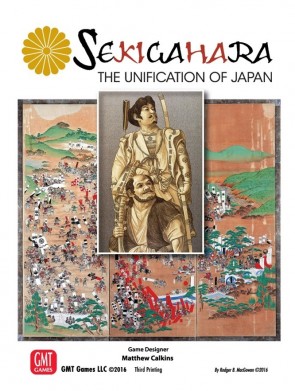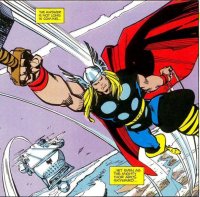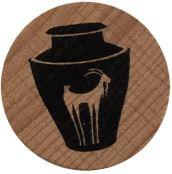Every so often you encounter a gaming experience that is so good it makes you re-evaluate your entire relationship to the hobby. Sekigahara- The Unification of Japan by designer Matt Calkins and published by GMT Games, offers one such experience.
Adrift and jaded in a sea of blinged-out ‘narrative’ titles, the elegance, immediacy, and depth of this beautiful game sent me hurtling back to the simple pleasures of my childhood mini-obsession with the classic Stratego, a game that has steadfastly remained in print for over 50 years. Minutes to learn, a lifetime to master, Sekigahara, like Stratego before it, places a brilliant mechanical conceit at centre stage, is immediately accessible and yet offers an oceanic infinity of relative depth and replay that dwarfs the sprawling boxes currently in the ascendant, as the hobby stumbles its way through the awkward prog-rock phase so beloved of plastic manufacturers everywhere.
And yet, despite its laser-like focus on gameplay, it nonetheless beguiles with its beauty, its modesty, its class. Despite its abstraction, it displays a mastery of theme.
Sekigahara then, has called me home.
The Domestication of the Samurai
Set in the year 1600, Sekigahara details the titular battle that saw a climactic seven-week finale to the centuries of bloody civil war that had riven the feuding daimyos of Japan. Detailed at length within the manual, the outcome of this battle will be well known to anyone with even a passing interest in Japanese history, given that one of the principal protagonists lent his name to the era that followed and ushered in over 200 years of unified isolationism.
In short, the story of Sekigahara is both an epilogue to the storied careers of the famously brutal Oda Nobunaga and the ‘rags to riches’ rise of his heir Toyotomi Hideyoshi, as well as a prologue to the mysterious Tokugawa Shogunate, an era that would see a veil drawn across the islands of Japan, obscuring them from foreign eyes for a further two centuries, whilst successfully domesticating its warrior class and knitting together the frayed social fabric of a long-divided nation. It’s a story of shifting allegiances, fragile pacts, opportunism, and bloody conflict. So – possibly the apogee theme for tabletop recreation by armchair historians and generals alike.
A strictly one vs one affair, players will take on the mantle of either the victorious feudal lord Tokugawa Ieyasu, or the loyal Ishida Mitsunari – the doomed defender of Hideyoshi’s child heir. Across approximately three hours they will recontest the seven-week campaign and seek to rewrite history, eking threads of opportunity from out of a dense fog of war, all whilst navigating a treacherous political minefield where loyalties are in constant question and fortunes waver precariously in the balance.
Ostensibly a war game, Sekigahara distinguishes itself from some of its more opaque cousins by virtue of its central mechanic. Army units are represented by blocks, each signifying a throng of approximately 5000 men who have sworn fealty to a different daimyo. The form, strength and allegiance of these units is obscured from your opponent’s view until forces collide and battle is drawn. Up until that point, the fog of war reveals only either an ominously teetering tower of blocks or perhaps the low hanging fruit of a single unit. But even then, all is not as it seems.
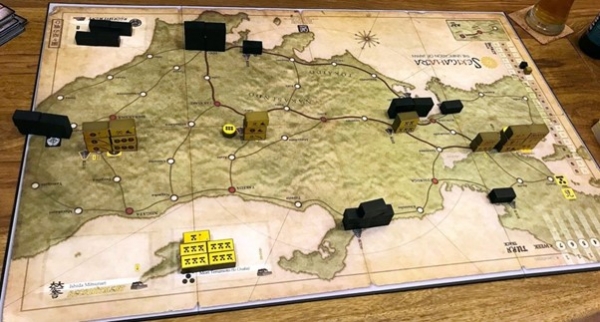
House of Cards
Every action in the game, from momentum to movement to mustering and melee is governed by a deck of cards that represent both potential actions and the wavering loyalty of your allied daimyos, each hedging their bets with a furtive eye fixed on the main chance. Commencing with a hand of five you’ll discard cards to bid for initiative, move or muster multiple units, and crucially, deploy armies of a matching allegiance in combat.
Those terrifyingly piled stacks of blocks you spy closing in on your position? They may yet prove a paper tiger should your opponent not possess the required hand to deploy them, reducing their ominous war machine to a literal house of cards. Or maybe their hand is packed with matching allegiances, they call your bluff and you’re utterly screwed. The canny general will ensure a little of both instances by balancing the makeup of their armies, ensuring a pragmatic response is available in most contingencies, but even with the best laid plans, the agonising tension of each collision is still guaranteed.
Like Stratego before it, the obfuscation of your opponent’s units makes every encounter a nervous gamble that lends emphasis to the maxim that no battle plan survives first contact.

Kōgeki!
Clashes commence by playing a matching card to deploy a unit of that faction, with each successive block deployed of the same faction adding both its value and an additional point of impact. Crest seven points of impact and you destroy one of your opponent’s blocks. Players will take turns fielding units until both decide to pass, either via an empty hand or cautious reserve. The defeated army loses one block, plus any others that fell to impact and must retreat to an adjacent location to lick their wounds, regroup or re-establish.
The most powerful armies in the game – those comprising many uniform blocks- are also the most difficult to field, requiring judicious use of cards and timing to utilise to their full effect. Weaker armies are easier to activate but will struggle to craft enough ‘impact’ during battles to eliminate multiple units, leading to a seesawing attrition, especially around the contested chokepoints of supply centres and castles.
Throughout the course of the war, you’ll be striving to conquer and hold both castles and supply centres, which will gift you with additional reinforcements and cards respectively, and which will be tallied at the conclusion of proceedings to determine the victor. An early victory can be snatched by any player brave or lucky enough to dispatch the enemy general, or in the case of the Tokugawa forces, by assassinating the child heir- a task that is easier said than done given his cloistered position in the fortified capital of Osaka.
The asynchrony runs deeper than that too, as opponents start with differing unit compositions, and the Ishida player can further draw upon the reserves of his most powerful daimyo Mori Terumoto, albeit only within the vicinity of the capital. Historically this represents Ishida’s distrust of Mori and Mori’s resulting reluctance to join the climatic fray, instead forming a bodyguard of sorts for the infant heir.
This historical element of honour, mistrust, and fragile alliance is brilliantly enabled throughout by the card system, in particular the coveted ‘loyalty challenge’ cards which can be played to disrupt an opponent’s attack phase by calling upon them to display further cards in their hand that match the allegiance of the unit most recently deployed. Failure to do so and will see that unit defect to the opposing side for the course of the battle – swayed by gold, rumour or perceived slight into abandoning their loyalties at the eleventh hour.
What this all adds up to is a game where every decision can have far reaching consequences and players will often have to choose between a selection of less-than-ideal circumstances, making the most of their hand relative to their position on the board and the composition of their armies. Mobility is sacrificed for strength, primacy for pliability. Every turn matters, and there is rarely a scenario in which the best option is obvious or your selection of actions is limited to the point where you feel robbed of agency. From your first tentative manoeuvres until your final desperate gambles, this game grips like a vice, and the 2.5-3 hour playtime is likely to arc swiftly by, as you wrestle with the thorny quandaries the struggle pitches at you with unyielding relish.
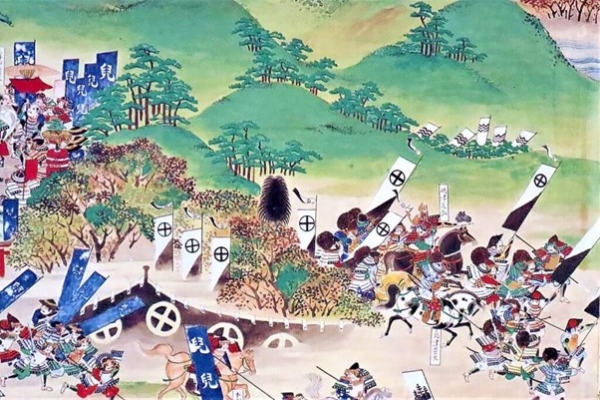
Form and Function
In keeping with a title that explores a culture with as deep and abiding a reverence for aesthetics as the Japanese, Sekigahara is a truly beautiful game. Equally fitting that in both presentation and play it is a reserved, austere, and modest beauty.
It is both worlds away from the tacky glamour of mini-stuffed ‘dudes on a map’ affairs and the dusty chit-stacking utilitarianism of more fastidious conflict simulators. It embraces abstraction and marries form with function in a manner that is tactile, functional and deeply pleasing, with every component from map to cards and especially blocks straddling a perfect line between the picturesque and the pragmatic. It is quick to make sense, the mechanical minutiae swiftly fading from your purview to make room for strategy as it flows with the practiced insistence of something truly refined.
I have rarely felt the depth of history enunciated with such a lithe and agile brevity as I did whilst enmeshed in the embrace of this game. Even after packing away the heft of its wooden warriors it lingered, robbing me of sleep until deep in the a.m. as I replayed the campaigns in my head.
I remain anxious to return and rewrite it all anew.

 Games
Games How to resolve AdBlock issue?
How to resolve AdBlock issue? 















